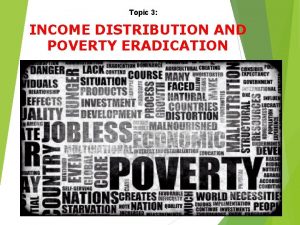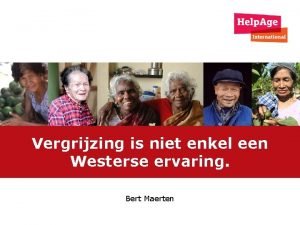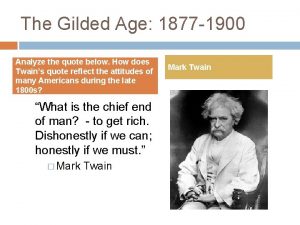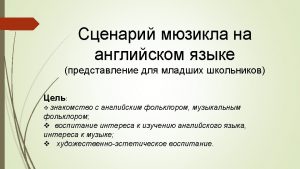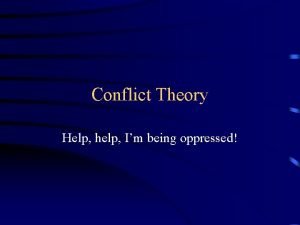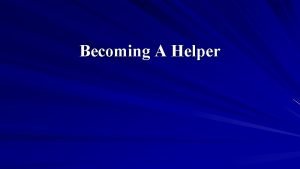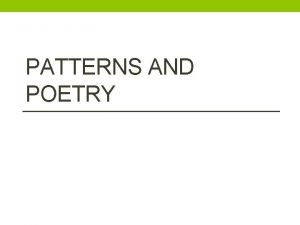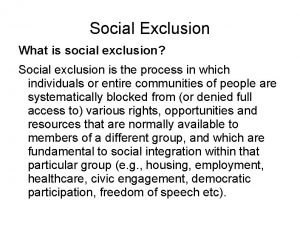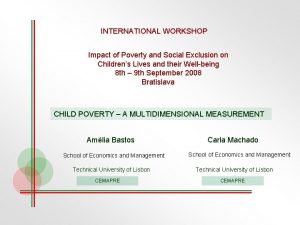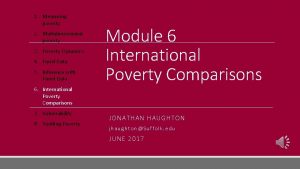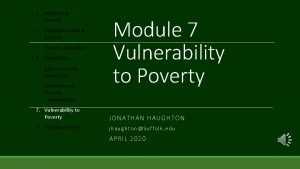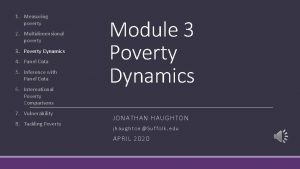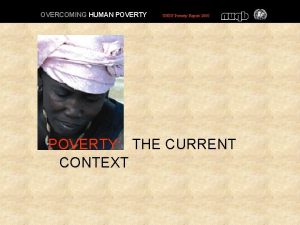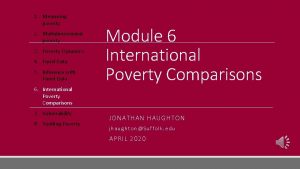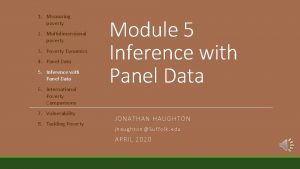Help Age International Old Age Poverty and Exclusion











- Slides: 11

Help. Age International Old Age, Poverty and Exclusion in Bolivia Beyond disaggregation? Fiona Clark Director for Programmes and Policy Latin America Regional Development Centre

Policies for older people Bolivia, despite being one of the poorest countries has a progressive policy environment for older people § Law 1886 for rights of older people including free health care, non-contributory universal pension (Bonosol), National Plan on Ageing. § Bolivian Government preparation for and participation in 2 WAA, Madrid § Decentralised government through law for popular participation and law of municipalities § PRSP (2001) recognises older people as vulnerable and recommends expansion of health insurance and cash transfers that benefit older people. § But these policies and laws are often not reaching the most marginalied or the poorest in rural areas. § Very little information about situation of older people in Bolivia

The data question What we already knew What disaggregation told us Older people made up 7% of Bolivia’s population. This will rise to 17% by 2050. In some localities of Bolivia older people make up nearly 20% of the population. 38 %of Bolivia’s population live in rural areas. 50% of older people live in rural areas. The rural population ratio between young and old is 22% compared to 15. 5% in urban areas. 59 % of Bolivians live in poverty. 63% of older people live in poverty. Chuquisaca, Oruro and Potosi are the “oldest” departments of Bolivia and they are also the poorest. 14% of the population could not read 69% of older people classify themselves as and write indigenous, 47% have no education and 32% are monolingual 50% of the adult population had completed primary education

The poverty of older people Older people live at higher risk of poverty than the overall population § 63% of older people live in poverty § 31% of older people do not have any kind of income § 22% of older people are pensioners § Only 13% of women and 10% of rural older people are pensioned. Older people working in isolated small communities in rural area of Oruro, on the altiplano. Most people live off the land consume most of what they produce.

Rural poverty § In rural areas older people’s poverty reaches 90%. § Older people in rural areas have only 39% of the income of older people in urban areas § In those areas with highest % of older people, 85 -100% incidence of poverty among older people Older women in Northern Potosi are amongst the poorest. Local partner CIPE supports them to grow vegetables to enhance their diets and improve food security for them and their families. Northern Potosi § One of the poorest areas of Bolivia 10+% of the population over 60 § Average older people-headed household consists of 2 older persons and 7 younger dependents § Some of these households have monthly incomes as low as 4 US dollars. § Ca. 70% of the older people in the Potosi department live in small one or two-room mud-brick houses with dirt floors and 71% of these houses do not have electricity. § Many speak only Quechua Source: Household surveys from local partner CIPE

Ethnicity, language and social exclusion Illiteracy, poor education and ethnic origin increase social exclusion among older people § 43. 5% of older people are illiterate (30% men, 70% women). § In rural areas 8 out of every 10 older women does not read or write. § 47% of older people do not have any kind of education, § 32% of older people speak only their native language (56% in rural areas). § For 61% of older people a native language is their mother tongue § Their income is a fifth of the income of older people who speak Spanish or both languages. The Awichas - a group of Aymara older people - work in the city and rural areas of El Alto to generate income and raise awarenss of the rights of older people

Access to services § 8% of older people have no form identity document (70% in rural areas, and 60% of older women) § At least the same number again, has errors in their identity papers § In 2005 of the 7000+ older people attended in the socio legal centres supported by Help. Age International, 43% of cases attended to related to problems of errors in identity documents § Not having these papers means older people cannot claim their right to free health care, their state pension and other rights under the law.

Help. Age International Older people contribute to the economic well being of their families § 46% of older people are economically active, 60% in rural areas. § 85% of the latter work in the informal agriculture sector or petty trading. § 18% of Bolivian households are headed by an older person and 60% of older people are heads of households § 32% of these are headed by an older woman, and § 9% are made up only of the older couple and grandchildren. The Awichas knit scarves, gloves and children's toys to sell.

So what does this tell us? § Older people face high levels of poverty and exclusion, especially in rural areas. § Older people are working to sustain their livelihoods and support other family members, especially grandchildren. § Distance from service providers, language barriers, and lack of documentation prohibit older people from accessing services, thus increasing their poverty and exclusion § Even if older people know about their rights they find it hard to access them due to the urban bias.

Beyond the data Policy implications § Data should be disaggregated by age, gender and ethnicity as a matter of course to allow for more targeted and informed policy development and implementation and to help prioritise government funds and international aid, targeting the poorest and in the most effective ways. § Any strategy in Bolivia that aims to alleviate poverty must directly and specifically target older people and their family (especially in rural areas) § Adult literacy programmes as well as increased government services that cater for monolingual native language speakers are essential. § Social protection, support of livelihood strategies, documentation and rights education are critical for older people to claim their entitlements

“Nothing about us, without us” Workshop on older people's rights, rural Bolivia
 Types of poverty
Types of poverty Vergrijzing
Vergrijzing Quote from the gilded age
Quote from the gilded age Stone age chronology
Stone age chronology Iron age bronze age stone age timeline
Iron age bronze age stone age timeline Self help and community help is the motto of
Self help and community help is the motto of Running running running
Running running running Once upon a time there lived an old man and an old woman
Once upon a time there lived an old man and an old woman Freesurfer troubleshooting
Freesurfer troubleshooting Help help i'm being oppressed
Help help i'm being oppressed Helper chapter 1
Helper chapter 1 Spagetti poem
Spagetti poem
